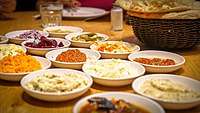Shirin polo
Shirin polo, also commonly known as Persian wedding rice, or Rosh Hashanah rice, is a traditional Persian Jewish rice pilaf that is commonly served to mark special occasions such as weddings,[4] Purim,[5][6][7][8] Pesach, Rosh Hashanah and the high holidays.[9][10]
 Shirin polo topped with dried barberries and crushed pistachios. | |
| Alternative names | Persian wedding rice, Jewish wedding rice, wedding rice, saffron rice, Purim rice, Rosh Hashanah rice |
|---|---|
| Type | Pilaf |
| Course | Side dish |
| Place of origin | Originally: Iran; but today also Israel, and the United States, and the Persian Jewish diaspora |
| Region or state | Middle East |
| Created by | Persian Jews[1][2][3] |
| Serving temperature | Hot |
| Main ingredients | Basmati or jasmine rice, water, salt, saffron or turmeric, crushed or chopped pistachios, Marcona almonds, or nuts, dried fruits such as barberries, dried apricots, dates, prunes, and figs |
Overview
Shirin polo is considered a celebratory dish in the Persian Jewish community, with its preparation and consumption typically being given reserved for weddings, birthdays, and holidays such as Rosh Hashanah or Pesach. The dish typically consists of basmati or jasmine rice that has been cooked in a unique method, involving soaking and boiling in a large amount of water, before being combined with a water-oil mixture containing saffron and/or ground turmeric, which is left to steam. Some variants of shirin polo has a crispy crust, which is later used as a topping for the dish, and is called tahdig. But many variants do not have the tahdig, and instead the rice is a uniformly yellow color due to the presence of saffron or turmeric. The cooked rice is then topped with myriad dried fruits such as barberries, apricots, and dates.[11][12][13]
Preparation
Shirin polo is typically prepared in a very unique method compared to other dishes made with rice. Rice such as basmati, jasmine, or other long-grain rice is soaked in cold water for several hours or even overnight. The rice is drained and rinsed, and added to boiling water where it is boiled to an al dente consistency similar to pasta. The rice is drained in a colander once more, and a slotted spoon is used to fluff the grains and help them steam somewhat. A mixture is made containing water, cooking oil, saffron or turmeric, sometimes along with other spices and seasoning. Oftentimes a pinch of saffron or turmeric is added to the bottom of a pot, the rice is then poured into the pot and the reserved water-oil-spice mixture is poured on top of the rice. The pot of rice is then covered with a kitchen towel that has been secured to the lid. The rice is left to cook over low heat, ountil the grains are cooked through and steamed throughout. Variants featuring a tahdig, or a crispy yellow rice crust, are often cooked for several hours until the tahdig is formed. Once the shirin polo is finished cooking and is ready to serve, it is carefully unmoulded onto a serving platter and the shards of the tahdig, or crispy rice, are placed on top as a garnish. The Persian wedding rise is then topped with a wide variety of dried fruits, such as apricots, barberries, dates, prunes, and nuts such as pistachio, almond, walnut, or hazelnuts. Depending on the family, the dried fruits and nuts may be left whole or chopped, as different families have different traditions concerning this with some preferring them dried fruits and nuts to be left whole, while others prefer them to be chopped into smaller pieces.[14]
Types
In addition to the main type of Shirin polo, a number of other types of the dish exist:[15][16]
- Orange peel Shirin polo Shirin polo topped with chopped, candied orange peel.
- Shirin polo with chicken
- Orange-almond shirin polo
See also
References
- Marks, Rabbi Gil. The Encyclopedia of Jewish Food.
- Solomonov, Michael. Zahav. HMH.
- Ottolenghi and Tamimi, Yotam and Sami. Jerusalem: A Cookbook. 10 Speed Press.
- Solomonov and Cook, Michael and Steven. Zahav. HMH.
- "Shirin Polo". Silk Road Vegetarian. Retrieved 11 January 2020.
- Klein, Dahlia. "Upside Down Persian Rice Dish Reveals the Story of Purim". The Forward. Retrieved 7 January 2020.
- Marks, Rabbi Gil. The Encyclopedia of Jewish Foods.
- "Raising A Mensch". The Philadelphia Jewish Voice. Retrieved 11 January 2020.
- Marks, Rabbi Gil. Olives Trees and Honey.
- Nathan, Joan (09/08/1993). "At Rosh ha-Shanah Persian Jews Play Themes and Variations". The New York Times. Retrieved 7 January 2020. Check date values in:
|date=(help) - Koenig, Leah. The Jewish Cookbook.
- Nathan, Joan. King Solomon's Table.
- Nathan, Joan. The Jewish Holiday Cookbook.
- Cook and Solomonov, Steven and Michael. Zahav.
- "SHIRIN POLO (PERSIAN SWEET RICE)". Food. Retrieved 7 January 2020.
- "Shirin Polo Sweet jeweled rice". Made in Marrow. Retrieved 7 January 2020.
